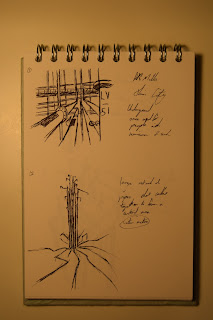Metropolis – Film Review
Directed by Fritz Lang, ‘Metropolis’ is a 1927 silent film,
said to have major influence on the science-fiction genre of film. Alongside
influencing the science-fiction genre of film, ‘Metropolis’ also features the
use of camera shots that are reminiscent of modern film making.
The story follows the character of Freder Fredersen, son of
the master of metropolis, who spots a woman while enjoying his excessive and
ignorant life style. It is from this point that he discovers the other side of
the city in which people suffer on mass. It becomes apparent to Fredersen that
there is another side to the city and becomes determined to help the people
below the ground.
“The story tells of a great city whose two halves--the
pampered citizens of the surface and the slaves of the depths--are ignorant of
one another.” (Roger Ebert, March 28, 1998)
‘Metropolis’ creates a clear divide between the people
forming two social classes, the workers and those who live above. Those fortunate
live above and are gifted with a free life in which they intoxicate themselves
and give into temptation.
This is witnessed in multiple scenes one such being when Maria’s
imitator presents herself while she dances in front of men who eventually give
into temptation and climb towards her, trying to reach out. Even those from
below who have seen the harsh nature of the city are not immune. One of the
liberated workers is tempted by the city’s entertainment district and ignores
the duty that he was charged with from his saviour, Fredersen.
Ebert stated that the two do not take too much notice in
each other and this is blatantly obvious during the beginning scenes. As the children
dressed in rags enter the upper levels the guards are unsure of how to react
while Fredersen himself is mesmerised by the group. This suggests that there is
a lack of both knowledge and understanding between the two creating clear
boundaries.
“Workers straining to move heavy dial hands back and forth” (Roger
Ebert, March 28, 1998)
On the contrary the workers lead a hard life completing minimal
tasks without truly knowing why. Only in death does the worker stop as they
feed the machine presenting striking imagery as Fredersen sees a machine
explode for the first time, suddenly transforming into a beast. Workers give up
their bodies to satisfy it walking to their deaths. Everything from motion to
clothing make the workers appear as drones. In comparison to those above who
have varying clothing and move individually those below move in rigid squares
and all wear the same dark, plain clothes.
“Its moral is that the brains and the hands fail when the
heart (love) does not work with them” (Mordaunt Hall, March 7, 1927)
Another theme expressed by the film is the importance of
speaking the same language and fully understanding one another. In the film
itself the importance is expressed through the ‘The Tower of Babel’. As Maria
tells the story with an ancient setting it raises thought questioning if man
will be able to cooperate with each other. Even with all the technology of the metropolis
this has not yet been realised and even today in our own society.
The film opens with a shot of the city in all its glory with
search lights scanning the buildings. While acknowledged for its establishment
in the science-fiction genre there is use of advance shots. This scene is an
example of this. The camera is set from a lower angle looking upwards towards
the multiple skyscrapers giving a sense of scale and grandeur. In addition the use
of lights furthers the depth as the light changes in scale to the distance of
the buildings giving an illusion of space.
In addition to the stunning still shots there are some more
modern innovations that are often seen in today’s cinema. One notable shot is
when the camera observes Maria’s scarf at a standstill before jumping towards it
with Fredersen’s hand, turning into a point of view shot. This makes the
audience feel as if they are there enhancing the experience.
“Some idea of the prodigious work in this production can be
imagined when it is said that about 37,000 extras were engaged in some of the
episodes” (Mordaunt Hall, March 7, 1927)
The acting style chosen has the actors being far more
dramatic, over expressing themselves making their actions far more clear. While
the acting style has not advanced far from Robert Wiene’s ‘The Cabinet of Dr.
Caligari’ (1920) the sheer size of the sets and extras overwhelms the audience.
In combination with the extravagant sets ‘Metropolis’ leaves both a moral
question and stunning visuals in the audiences mind. This results in presumably
one of the most influential films in history.
“Before you congratulate 1982's "Blade Runner" for
anticipating the Times Square of today, see how eerily accurate "Metropolis"
was” (Jami Bernard, Friday, July 12, 2002)
Bibliography




















































